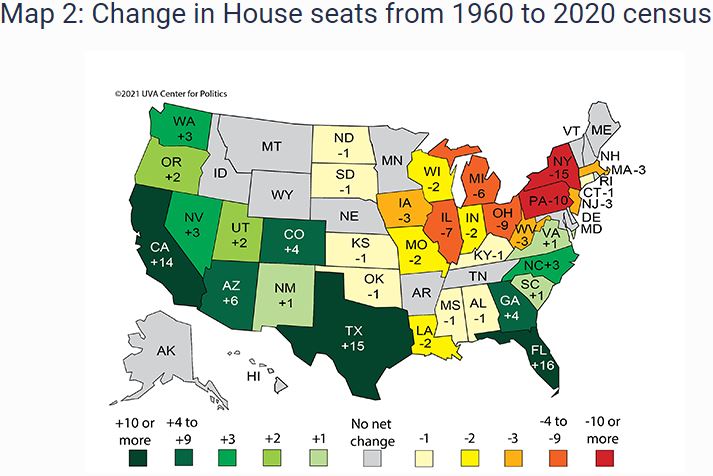More Census 2020 Takeaways
The trends over the last half century are really something.
Yesterday afternoon, I noted that the preliminary Census results were good news for Republicans, because of a continued shift from the Rust Belt to the Sun Belt. With more time to evaluate the results, some other interesting tidbits have emerged.
WaPo‘s Aaron Blake notes that there were some mild surprises:
*Minnesota avoided losing a seat very narrowly — to the point that New York would have taken the seat if it had just 89 more people. (Respond to the census, people!)
*Texas gains only two seats, rather than three.
*Florida gains only one seat, rather than two.
*Rhode Island will not lose one of its two House seats, after all.
*Arizona doesn’t gain a seat, after all.
That a difference of 89 people is the difference in one US Representative, when they represent an average of 761,952 people (331,449,281/435) is just astounding. (Not mentioned by Blake but noted by Kyle Kondik and others is that my erstwhile home state of Alabama, which had been expected to lose a seat, held steady at 7.)
The steady movement to the Sun Belt has been astounding:
*New York has steadily declined from 45 districts in the 1940s to 26 today. On the plus side, it’s the first reapportionment since then that it hasn’t lost multiple seats.
*On the other end of the spectrum, Florida has gained seats in every reapportionment over the same span, growing from eight in the 1950s to 28 today. It now takes sole possession of the third-biggest electoral vote prize and House delegation — behind California and Texas — after previously sharing those with New York.
*No, it didn’t gain three seats as it might have hoped, but Texas continues to be the winner among winners, growing from just 26 electoral votes as recently as 1980 to 40 today. That also comes with the asterisk that Democrats have made the state increasingly competitive, but they didn’t come nearly as close to winning it as they had hoped in 2020, still losing it by more than five points in the presidential election.
*California, which has confronted unusually sluggish population growth, lost a district for the first time ever.
Kondik supplies this graphic to bring the point home:

And, just to illustrate the growing absurdity of the Electoral College that Steven Taylor and I have been going on about for years, Blake notes:
[I]f you overlay the 2000 presidential results — three reapportionments ago — on the current electoral vote totals, George W. Bush’s narrow [2000 election] win with 271 electoral votes becomes a much more decisive win with 290.
This, you may recall, was one in which Bush’s opponent, Al Gore, received 543,895 more votes.






Is this actually good news for Republicans? The states gaining seats are all getting bluer, and the states getting redder are all losing seats.
Has anyone done this same analysis with different models of lifting the congressional cap? My assumption is NY still declines quite a bit, but I have to imagine it retains more seats.
Additionally, I wonder how much the numbers would change if the census had been conducted this year given COVID-19 related migration (I have a number of colleagues who have decided not just to leave the Bay Area, but California, now that remote work is an option).
@Stormy Dragon: It’s a mixed bag, though the GOP gets a marginal boost in terms of the 2020 map, which would have yielded 303-235 EVs under the current apportionment rather than 306-232. But yes, some of the trends could end up hurting the GOP–if for instance NC or Texas turn blue; meanwhile, the red-trending Penn., Ohio, and Michigan have lost seats.
@mattbernius:
If the Census in New York had counted just 89 more people it would not be losing a seat in Congress.
https://www.cnn.com/2021/04/26/politics/new-york-census-house-seat-electoral-college-vote/index.html
Humans – and I include myself – tend to be positively phototropic: we like light. We migrate into the light. Where is the light? Not in Ohio.
The single biggest reason I live in LA and not London is light. London is gray, Los Angeles is golden, (with a band of brown smog on the horizon).
@mattbernius:
Former OTBer Chris Lawrence was doing some back-of-the-envelope analyses on twitter re: congressional cap. https://twitter.com/lordsutch/status/1386796538626772993
Not as in depth as what you are probably looking for.
@Michael Reynolds:
Huh?
For most of human history, around 90% of the population lived within a few miles of the coast. I think that number is now something like 85%.
At the same time, for most of human history the amount of people living in more desert-like areas (even those near coasts) like Texas and LA was pretty small. Even though there was, indeed, sunlight there. What changed for some particular desert-like areas was that jobs arrived there. And in LA’s case, jobs and an asthetic de-desertification fueled by emptying the Colorado river.
@Neil J Hudelson:
Thanks. That is exactly what I was looking for.
To me the map shows the rusting of the rust belt. The big industries of Ohio, Michigan, Illinois, etc are gone. Agriculture also employs fewer people. The economy of Texas is thriving with large components from petroleum, defense, aerospace, and agriculture. This may mean that there is a potential for volatility. I lost some money in the 1970s in a partnership in Houston when oil had a downturn.